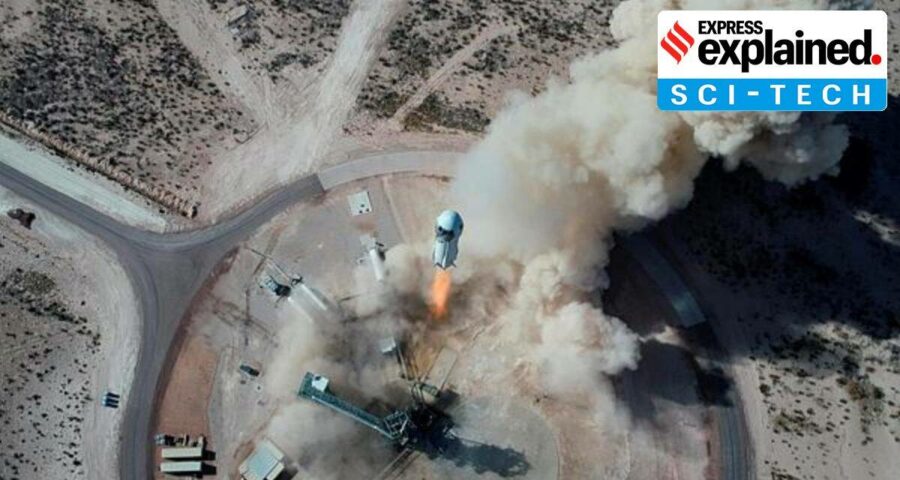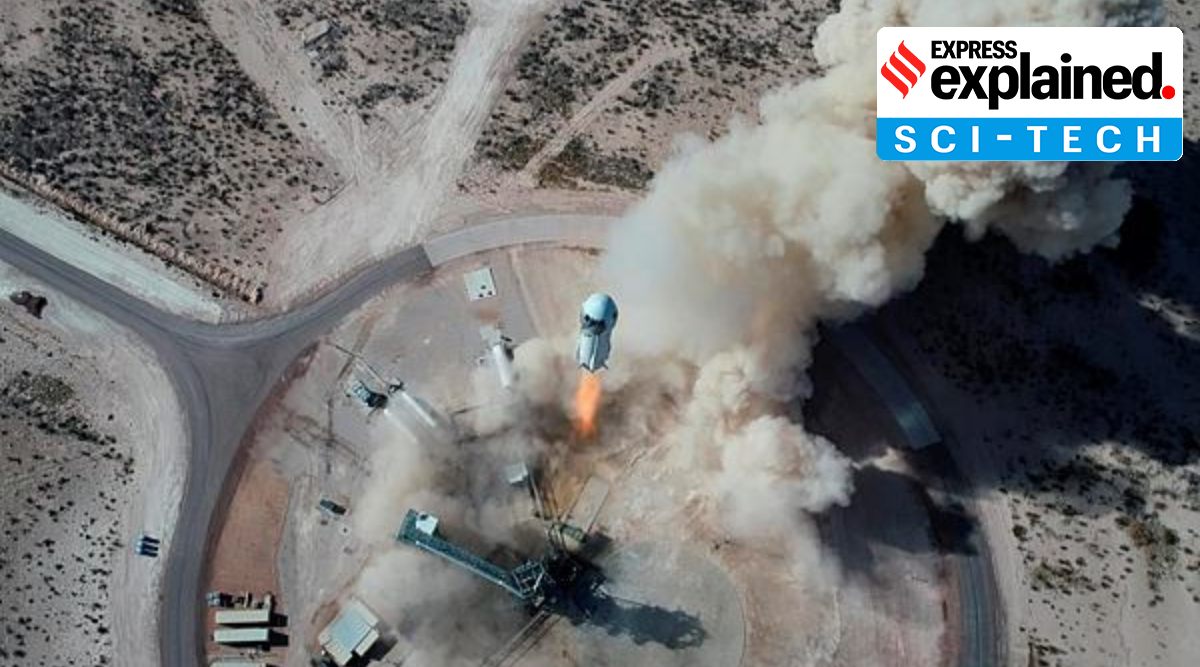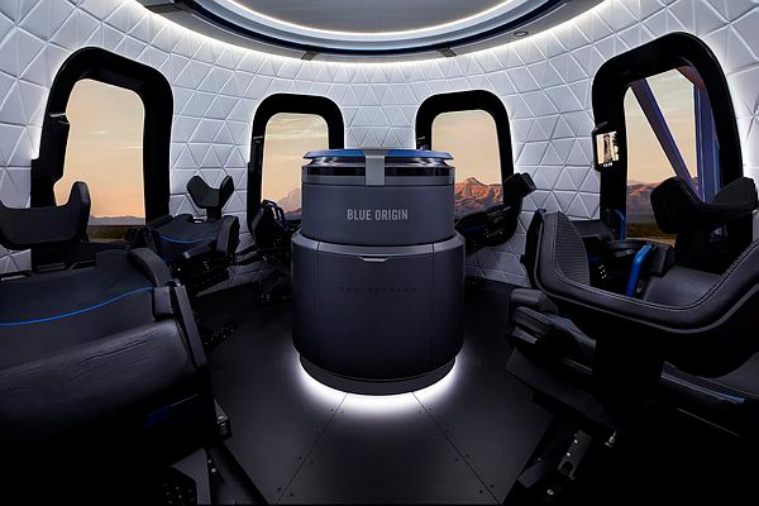The capsule is entirely automated, unlike Richard Branson’s Virgin Galactic rocket plane that required two pilots to get him to space and back a week ago.
When Blue Origin launches people into space for the first time, founder Jeff Bezos will be on board. No test pilots or flight engineers for Tuesday’s debut flight from West Texas, just Bezos, his brother, an 82-year-old aviation pioneer and a teenage tourist.
The capsule is entirely automated, unlike Richard Branson’s Virgin Galactic rocket plane that required two pilots to get him to space and back a week ago.
Branson’s advice? “Just sit back, relax, look out of the window, just absorb the view outside,” he said on CBS’ “The Late Show with Stephen Colbert.”
Differences in quirks and rockets aside, the billionaire rivals are gearing up to launch just about anybody willing to shell out hundreds of thousands of dollars for a brief up-and-down space hop.
Newsletter | Click to get the day’s best explainers in your inbox
A brief look at what awaits Bezos and his passengers:
Bezos on board
Bezos created Blue Origin in 2000, a move that he said prompted his high school girlfriend to observe, “Jeff started Amazon just to get enough money to do Blue Origin — and I can’t prove her wrong.” He has said he finances the rocket company by selling $1 billion in Amazon stock a year. Bezos caught the space bug at age 5 while watching Neil Armstrong and Buzz Aldrin’s moon landing on July, 20, 1969. He chose the 52nd anniversary for his own launch. Enamored by space history, Bezos named his New Shepard rocket after Alan Shepard, the first American in space, and his bigger, still-in-development New Glenn rocket after John Glenn, the first American in orbit.The 57-year-old Bezos — who also owns The Washington Post — stepped down as Amazon’s CEO earlier this month and last week donated $200 million to the Smithsonian Institution to renovate its National Air and Space Museum and launch an education center. “To see the Earth from space, it changes you. It changes your relationship with this planet, with humanity,” he said. “It’s a thing I’ve wanted to do all my life.”
Who else is flying
Bezos personally invited two of his fellow passengers — his 50-year-old brother Mark, an investor and volunteer firefighter, and female aviation pioneer Wally Funk. Joining them will be Oliver Daemen, a last-minute fill-in for the winner of a $28 million charity auction who had a scheduling conflict. At age 82, Funk will become the oldest person in space. She was among 13 female pilots — the so-called Mercury 13 — who took the same tests in the early 1960s as NASA’s Mercury 7 astronauts, but were barred because of their gender. “Finally!” Funk exclaimed when offered a seat alongside Bezos. As for the Dutch Daemen — who at 18 will become the youngest person in space — his financier father bid on the capsule seat in June, but dropped out when the price soared. Blue Origin came calling just over a week ago, after the unidentified auction winner switched to a later flight. The teenage space fanactic, who starts college this fall, is Blue Origin’s first paying customer; no word on what his ticket cost.
Rocket and capsule
While Bezos won’t be the first boss to ride to space on his own rocket, he can lay claim to strapping in for his company’s first human launch. He’s also aiming higher, with an anticipated altitude of about 66 miles (106 kilometers) versus Branson’s 53.5 miles (86 kilometers). Blue Origin’s 60-foot (18-meter) New Shepard rocket will accelerate toward space at three times the speed of sound, or Mach 3, before separating from the capsule and returning for an upright landing. The passengers will experience three to four minutes of weightlessness, before their capsule parachutes onto the desert just 10 minutes after liftoff. That’s five minutes less than Alan Shepard’s 1961 Mercury flight. Blue Origin, though, offers the biggest windows ever built for a spacecraft. Bezos purchased the desolate, parched land for launching and landing rockets. The closest town is Van Horn, population 1,832.
Track record
Blue Origin has completed 15 test flights to space since 2015, carrying up experiments, children’s postcards and Mannequin Skywalker, the company’s passenger stand-in. Except for the booster crash-landing on the first trip, all the demos were successful. One rocket ended up flying seven times and another five. The capsules also were recycled. Blue Origin deliberately aborted a couple flights after liftoff to test the emergency escape system on the capsule. The pace seemed slow compared with the competition, and many wondered why Blue Origin — its motto Gradatim Ferociter, or step by step ferociously — was taking so long to launch people. Based in Kent, Washington, the company kept fairly mum on its launch plans. Bezos finally announced “it’s time” following the last test flight in April, a dress rehearsal that saw mock passengers briefly climb aboard before liftoff.
What’s next
Blue Origin is expected to open ticket sales soon after Bezos flies. There’s no immediate word on how much rides will cost. The fourth seat on the upcoming flight was auctioned off for $28 million. Nineteen space advocacy and education groups are getting $1 million each as a result, with the rest to be used by Blue Origin’s Club for the Future for its own education effort. While the diminutive New Shepard is meant to launch people on brief flights to the edge of space, the mega New Glenn will be capable of hauling cargo and eventually crew into orbit from Cape Canaveral, Florida, possibly beginning late next year. Blue Origin also has its eyes on the moon. Its proposed lunar lander, Blue Moon, lost to SpaceX’s Starship in NASA’s recent commercial competition to develop the technology for getting the next astronauts onto the moon. Blue Origin is challenging the contract award, as is Dynetics, the other competitor.
Source: Read Full Article




